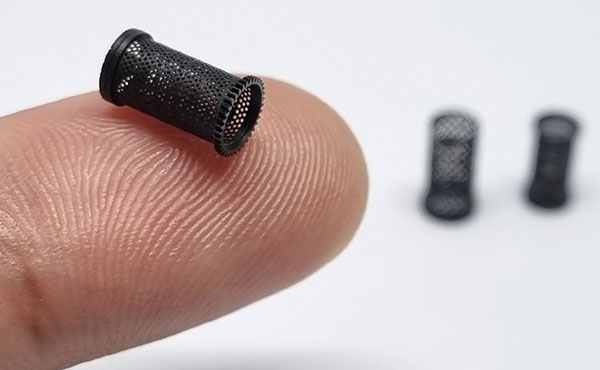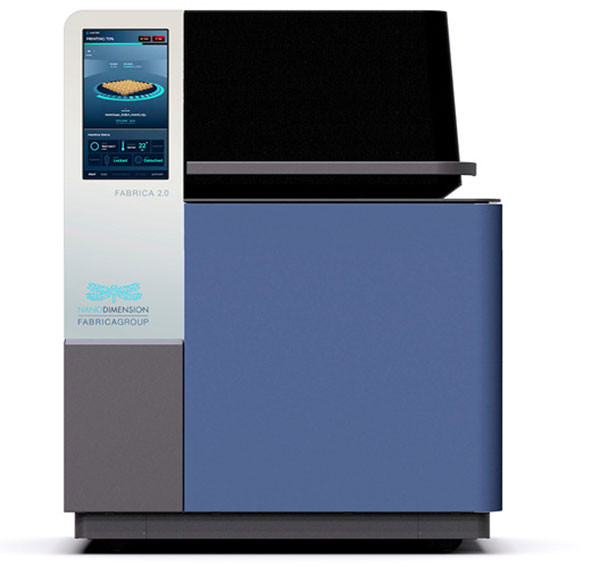3D Printing Mingles With Micro
As products gain complexity and shrink in size, AM is advancing to accommodate production of micron-level parts.

Nanofabrica enables 3D printing of parts of sub-micron accuracy and high surface finish. Image courtesy of Nano Dimension’s Fabrica Group.
Latest News
December 15, 2021
Propelled by materials advances, innovative techniques and performance improvements, additive manufacturing (AM) has come a long way since the days of experimentation for prototyping or consumer hobbyist applications.
As AM gains traction for full-scale production use cases, the technology is evolving to conquer another new frontier: The production of micro-scale parts that were previously out of reach with conventional 3D printing technologies.
Demand for micro-scale parts is booming as products gain complexity and decrease in size to accommodate a smaller footprint. In the health care sector, for example, there is evidence of more miniaturized drug delivery devices, wearables on a chip and hearing aids. At the same time, the myriad chips, arrays and sensors that power electronics devices, defense equipment and a new generation of semi- and fully-autonomous vehicles are also rapidly contracting as they gain sophistication and empower innovative use cases.
“There’s a whole trend around making things smaller and it’s happening across a lot of different industries,” says John Kawola, CEO of Boston Micro Fabrication (BMF), a maker of micro-precision 3D printers that uses projection micro stereolithography (PµSL) technology.

The P150 is BMF’s entry-level micro-precision 3D printing system, sporting a lower price point and print resolutions down to 25μm. Image courtesy of Boston Micro Fabrication (BMF).
“As things get smaller, it gets harder to make parts conventionally with molds or machining and, in some cases, it’s a constraint. Companies aiming to make something like a sensor or camera smaller run up against the fact that the molding costs to make the part are 10 times more expensive than if they made the part larger.”
Micro 3D printing, currently dominated by only a handful of players, is attempting to serve this portion of the market, which has been out of reach for many of the traditional 3D printing technologies, including laser sintering, fused deposition modeling (FDM) and stereolithography (SLA), according to Kawola.
Avi Cohen, executive vice president of global sales at Fabrica Group, now part of Nano Dimension, makes the case that micro-scale 3D printing represents a major pivot point in the 3D printing industry, which has evolved and matured at a fairly slow clip over the last few decades.
“I’ve been involved in 3D printing since the late ’90s and it always trends towards printing bigger—no one ever said how small can we get,” Cohen says. “But there’s a wind of change in the industry in the way things are becoming smaller today. This industry has seen incremental change with printers operating a few seconds faster or enabling you to build something 5 millimeters longer. With this technology, anything as small as you can imagine is printable. That is what’s changing.”
Economics of Micro-scale AM
There are many reasons why the economics of micro-scale AM is sound for specific types of applications. Consider the relatively small and simple plastic toy parts typically associated with consumer-grade 3D printers. For companies looking to make comparable parts at scale, building a mold would be relatively cost-effective, making traditional injection molding an optimal choice for a manufacturing approach.
Yet the dynamic completely changes if the small part is a complicated electrical connector with tolerances of plus or minus 10 microns. In that example, the expense for producing a mold for such a part would be an exponential leap, potentially costing upward of $500,000, given the need for tight precision and accuracy.
“What’s proven to be true over the last 10 years is that 3D printing makes sense for parts with relatively low volumes of production,” Kawola explains. “If you’re printing 1 million Happy Meal toys, you’re going to create a mold because the math [for 3D printing] doesn’t work. But if you’re making 10 or 500 or 1,000 parts, 3D printing make more sense than injection molding.”
Now consider micro-scale levels where the math becomes even more compelling, Kawola contends. Material costs don’t factor into the decision as much because with parts of this size, the quantities of materials used are so small, comparatively.
“These are tiny little parts so cost is much more driven by setup times and tooling costs,” he explains. “The break-even tooling cost is much higher on micro parts so the [traditional 3D printing] math changes. Now this medium might make sense for 10,000 or even 100,000 production parts.”
Beyond the economics driving micro-scale printer purchase decisions, there is also the cost factor of how to price parts produced with these technologies, particularly for service bureaus. Given that parts weighing less than 1 gram require very small amounts of material, production costs keyed to material usage won’t adequately reflect the labor and design effort that went into creating and 3D printing a micro-scale part, says Cohen.
“The pricing of micro parts is still unclear,” Cohen says. “The medium is faster and cheaper than the alternative, but time will tell how much the market is willing to pay.”
Micro-Scale 3D Printers Emerge
As of now, the micro-scale 3D printer market is pretty nascent with only a handful of players, with many still operating in early development or start-up mode. In addition to BMF and Fabrica Group, NanoScribe offers the Quantum X based on laser lithography and a two-photon polymerization (2PP) and aimed at rapid prototyping and wafer-scale batch production of 3D microparts in biomedical devices, micro-electromechanical systems (MEMS), microfluidics and other use cases.
3D Micro Print GmbH, a cooperation between EOS GmbH and 3D-MicroMac AG, offers a platform based on micro laser sintering technology, which combines the advantages of AM and micro machining.
Fabrica Group, acquired in April this year by Nano Dimension, a company involved in printed electronics, is another one of those upstarts. Its Tera 250, now renamed the Fabrica 2.0, is based on a digital light processor (DLP) engine and is already being used to deliver micro-level resolution for medical device, micro-optics, semiconductor, micro-electronics, MEMS, micro fluidics and life sciences applications, including casings for micro-electronics, micro valves, micro syringes and an array of other surgical devices.

The key to Fabrica 2.0 is its design that combines DLP with semiconductor lithography and advanced optics to achieve repeatable micron-levels resolution. This approach ensures the printer can reach a resolution of 1 micron over a large build volume of 50x50x100 mm. This means it can print one large, precise part or fit many micro-scale parts together on a single build. The Fabrica 2.0’s smart, adaptive optical system operates in a closed-loop fashion, so the machine is continually monitoring itself and the print and adjusting to ensure small, highly detailed and accurate parts, Cohen says.
Along with the specialized optical system, the Fabrica 2.0 achieves a high level of stability and repeatability via its robust construction, which includes a metal chassis and granite table to ensure rigidity and accuracy. There are also servo controls to promote precision.
“There is no movement within the system—no freedom or ability for tolerances to expand in heat or shrink in cold,” Cohen says. “Everything stays solid.”
As for materials, the Fabrica 2.0 uses Precision N-800, an ABS-like material that combines strength and flexibility along with the Performance N-900, which leverages ceramic materials for 1 micron resolution.
BMF recently added the microArch S230 to its line, its most advanced, highest resolution model in its micro-scale 3D printer family. The microArch S230 is built on BMF’s PµSL technology, which allows for rapid photopolymerization of an entire layer of liquid polymer using a flash of UV light at micro-scale resolution.
Compared to previous BMF models in the 2μm series, the microArch S230 supports a larger build volume (50x50x50 mm) and prints up to five times faster. The printer also features automated laser calibration and controlled processing technology to aid in the production of highly precise 3D printed objects.
“You can’t get to 10-micron accuracy if you’re not controlling the movement of the vat [of resin], and most other technologies don’t control to that level,” Kawola claims.
BMF offers various materials for use with the printers, including an additional three: AL [Alumina] Ceramic, a ceramic resin meant for applications like tooling, casing, housing and medical devices; HT 200, a high-strength resin designed for end-use in electrical connectors and electrical components; and magnesium titanate (MT) ceramic, suitable for millimeter-wave applications like antennas and other electronics components.
As AM capabilities grow in sophistication and scale, industry players say it’s important for engineering and development organizations to realize maturity and progress is not just about getting bigger and better, but the ability to go small.
“Companies are designing big parts, but they don’t know how to do small,” Cohen says. “The market needs to be micro-manufacturing aware … because much of these innovations couldn’t happen with traditional means of manufacturing.”
More Boston Micro Fabrication Coverage

Subscribe to our FREE magazine, FREE email newsletters or both!
Latest News
About the Author
Beth Stackpole is a contributing editor to Digital Engineering. Send e-mail about this article to [email protected].
Follow DE






